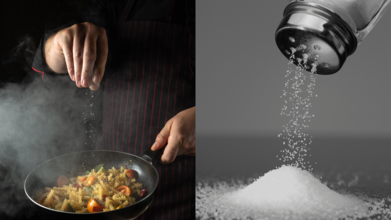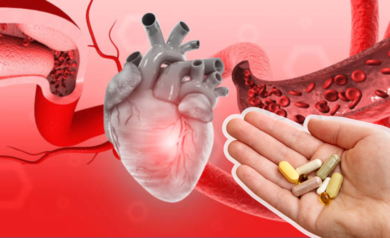- Health Conditions A-Z
- Health & Wellness
- Nutrition
- Fitness
- Health News
- Ayurveda
- Videos
- Medicine A-Z
- Parenting
- Web Stories
Study Warns: Consuming Too Much Salt Could Cause Inflammation In Brain, Lead To High BP

Credits: Canva
We all love a “little more” salt in our dishes. But it may be silently messing with your brain in ways you never imagined. According to a new study, overdoing it with salt does not just raise your blood pressure through your kidneys. It could actually set off a chain reaction in your brain that ends up with your arteries under siege.
Salt, your brain, and the “missing link”
Researchers at McGill University have uncovered what they call a crucial “missing link” between high salt intake and high blood pressure. While most of us have been taught that hypertension largely stems from the kidneys, this study flips that idea on its head. Certain types of high blood pressure, it turns out, may actually start in the brain.
“This is new evidence that high blood pressure can originate in the brain, opening the door for developing treatments that act on the brain,” explained Masha Prager-Khoutorsky, lead researcher and associate professor in McGill’s Department of Physiology.
Until now, the brain’s role in high blood pressure has been largely ignored. “The brain’s role in hypertension has largely been overlooked, in part because it is harder to study. But with new techniques, we are able to see these changes in action,” she added.
Rats, junk food, and more
To test the theory, the team used rats as stand-ins for fast-food-loving humans. Their subjects were put on a diet containing 2 per cent salt, the equivalent of a person living off bacon, instant noodles, and processed cheese.
The results lead to their brains lighting up like warning sirens. High salt intake triggered immune cells in a specific brain region, sparking inflammation. This, in turn, caused a surge in vasopressin, a hormone that usually keeps tabs on kidney function, salt balance, and blood pressure. Unfortunately, too much vasopressin sent blood pressure soaring.
In short, a diet of salty snacks did not just burden the kidneys. It rewired the brain’s chemistry, paving the way for hypertension to take hold.
It matters more than you think
High blood pressure is often called the “silent killer” for a reason. It rarely comes with symptoms but can strike dramatically in the form of heart attacks or strokes. Left unchecked, it can also lead to kidney failure, heart failure, vision problems, or even vascular dementia.
The McGill findings could explain why some people’s high blood pressure stubbornly resists kidney-focused treatments. If the root problem lies in the brain, addressing only the kidneys is like fixing the plumbing when the real leak is in the ceiling.
Panicking does not help
It is a wake-up call to pay closer attention to hidden salt. The real issue is not the pinch you add to your curry. It is the packaged and processed foods, from crisps and biscuits to soups and ready-made sauces, that stealthily load your body with sodium.
Start small. Check food labels. Swap salty snacks for nuts or fruit. If you really crave flavour, lean on herbs, spices, and citrus instead of reaching for the salt pot. Your taste buds adapt surprisingly quickly.
Blood pressure
Of course, salt is not the only one that leads to high blood pressure. Smoking, excessive drinking, sedentary habits, and genetics all add to the mix. Cutting down on alcohol and cigarettes, moving your body more, and booking a regular blood pressure check can all make a difference. You do not need a full lifestyle change overnight. Even small, steady tweaks can keep your blood pressure in check and your brain from turning into an inflammation hotspot.
Could Omega-3 Fatty Acids Be The Dietary Fix For Your Kids Nearsightedness?

Credits: Canva
If your child spends hours glued to screens, you’ve probably worried about their eyesight. But here’s something surprising, could a nutrient as simple as omega-3 help protect them from nearsightedness? A new study says yes—and the findings might change how parents think about everyday nutrition and eye health.
omega-3 fatty acids have been touted for their potential to promote heart health, reduce inflammation, and even guard the brain. They're what make salmon, walnuts, and chia seeds so well-touted as "superfoods." But scientists are now discovering another intriguing possibility: omega-3s might help guard vision too.
Nearsightedness, or myopia, is on the verge of becoming the most prevalent child health problem in the world. It's no longer out of the ordinary for a kid to receive their first eyeglasses before the age of ten. An estimated nearly half of the world's population may suffer from myopia by the year 2050. Heredity has something to do with it, but so does lifestyle—particularly during an era of digital screens, restricted outside playtime, and an unbalanced diet.
The question researchers are raising is- Does what children eat make a quantifiable difference in the way their eyes grow? Based on new research released in the British Journal of Ophthalmology, the answer may be yes.
The research, conducted by Dr. Jason Yam, a professor of ophthalmology at the Chinese University of Hong Kong, monitored over 1,000 children aged 6 to 8. Researchers monitored their diets via questionnaires and compared them with comprehensive eye examinations. Here's what they discovered:
Youngsters with the lowest intake of omega-3 fatty acids had the longest axial length (from front to back of the eye). A longer axial length is associated with myopia directly.
Children with a greater intake of omega-3 had the shortest axial length, indicating a shield against nearsightedness.
Individuals with greater intake of saturated fats—found in foods such as butter, palm oil, and red meat—had a more pronounced indication of developing myopia.
Simply put, kids who consumed more omega-3s were less likely to exhibit the physical eye changes that cause nearsightedness.
Dr. Yam and his researchers concluded that omega-3s could be "a potential protective dietary factor against myopia development."
What Is Nearsightedness or Myopia?
Nearsightedness results when the form of the eye leads light rays entering the eye to converge ahead of the retina, instead of directly on it. This causes objects in the distance to blur.
The condition usually arises during childhood and stabilizes by adulthood, but its complications can stretch much further than the prescription for glasses. High myopia raises the risk of retinal detachment, glaucoma, and cataracts in later life. Changes in lifestyle in today's world are driving its increase:
- Increased screen time and less exposure to natural light outdoors
- Sedentary lifestyles and less physical activity
- Nutritional deficits that impact bone and eye growth
The new research indicates that omega-3s could directly affect eye growth, perhaps by enhancing blood supply and maintaining a healthy retinal and corneal growth.
How Omega-3s Helps Protect Vision?
Omega-3 fatty acids are essential nutrients that the body is unable to generate by itself and, therefore, need to be obtained from diet. They come in three forms: ALA (alpha-linolenic acid), present in vegetable sources such as walnuts, flaxseeds, chia seeds, and hemp seeds; DHA (docosahexaenoic acid), a brain and retina structural component crucial to health, present mainly in fish, algae, and other sea foods; and EPA (eicosapentaenoic acid), which is present in fish and algae as well, notable for its anti-inflammatory effect.
Of these, DHA is particularly vital to eye function and development. One of the richest tissues in DHA, the retina has been found through human and animal research to have compromised vision from deficiencies in early life. New evidence now indicates that the role of omega-3s is not limited to cardiac and neurological well-being but could also play a protective function in maintaining the vision of children through formative developmental years.
How do Parents Assist in Precluding Myopia in Children?
Across the world, nearsightedness rates are rising at alarming rates. By 2050, almost 5 billion individuals will be myopic. The increase is particularly steep in East Asia, where intense schooling pressures, prolonged near vision work, and diet changes overlap but Western nations are following fast. More screen time for kids, less outdoor time, and processed food diets rich in saturated fats have provided an ideal environment for eye issues.
If left unchecked, myopia's burden will stress health systems and impact quality of life for millions. Prevention measures—such as dietary interventions—are therefore critical.
Other Health Benefits of Omega-3s
This is not the first instance that omega-3s have been associated with eye wellness. Earlier studies have identified that they can lower the risk of:
Age-related macular degeneration (AMD) is a common cause of blindness among older adults
Dry eye disease: Omega-3s may enhance tear quality and alleviate inflammation
- In addition to eye care, omega-3s are linked with:
- Reduced risk of heart disease
- Enhanced brain function and reduced dementia risk
- Improved mood and alleviated depression symptoms
- Lessened inflammation in the body
Another study published by King's College London has recently discovered that omega-3s may also lower the risk of Alzheimer's in women, further highlighting their wide-ranging protective benefits.
How to Add Omega-3 Rich Foods in Your Diet?
For households wishing to enhance children's omega-3 levels, diet is the key.
Oily fish: Salmon, mackerel, sardines, and tuna are richest in DHA and EPA.
Plant sources: Walnuts, chia seeds, flaxseeds, and hemp seeds contain ALA, which the body can partially convert into DHA and EPA.
Algae-based supplements: A vegetarian option for those following a plant-based diet.
Experts advise that children consume at least two portions of fish every week, although supplements can be beneficial in instances of diet limitations or fussy eating.
Why Balance Is Important in Your Diet?
Although omega-3s seem to be protective, the research also points out what not to excess: saturated fats. Diets rich in processed meats, butter, and palm oil were linked with higher indicators of myopia in children.
Diet is only one part of the equation. Outdoor activity, reduced screen time, and frequent eye exams are all just as crucial in safeguarding children's vision.
The new study doesn't show omega-3s can prevent nearsightedness outright, but it provides strong evidence that nutrition is involved in eye development. For caregivers and parents, it's another reminder that what kids eat influences not only how they grow up, but how they experience the world literally.
As Dr. Yam's group points out, omega-3s are turning out to be a "potential protective dietary factor against myopia development." Whether in a piece of grilled salmon or a handful of chia seeds, increasing the family diet with more omega-3s may be a practical, easy solution to healthier eyes.
Cardiologist Shares 3 'Healthy Breakfast' Foods That Silently Raise Your Blood Pressure

(Credit-Canva)
While we blame white rice, morning drinks like coffee or tea, a simple unsuspecting breakfast could be the culprit behind your rising blood sugar. Many people have switched to healthier options for their breakfast favorites, whether it is sugarless coffee, or whole fruits. However, not everything we consider healthy is true. Dr Sanjay Bhojra, a Board-Certified Cardiologist, lists 3 breakfast items we believe to be healthy, which could be the silent cause behind your rising blood pressure.
What ‘Healthy’ Foods Are The Cause Of Blood Pressure Spike?
Dr Bhojra lists these 3 food items as if they might actually be harming your cardiovascular system.
- Whole grain toast.
- Instant oatmeal packets.
- Even certain granolas.
While they are often recommended by doctors and found on every "heart-healthy" list, these seemingly harmless foods contain hidden components that can lead to an unhealthy start to your day. This can unknowingly cause problems that build up over time, affecting your long-term heart health.
How Does Unhealthy Breakfast Affect Your Body?
Dr Bhojra explains that starting your day with these foods can cause your blood pressure to spike before 9 a.m. This happens because of a combination of factors. The hidden sodium in many of these products leads to fluid retention, causing your body to hold onto more water. Additionally, the refined carbohydrates can cause a sharp increase in insulin and stress hormones. Together, these effects can drive inflammation in your body right at the beginning of the day, setting a negative tone for your cardiovascular system.
What Are The Long Term Impacts of High Blood Pressure?
When your blood pressure consistently remains high in the morning, it can gradually chip away at your cardiovascular health. This persistent elevation can put extra stress on your heart and blood vessels, potentially leading to more serious issues over time. Instead of these foods, a better approach is to choose a breakfast that works to stabilize your blood sugar, reduce inflammation, and truly support a healthy heart from the moment you wake up.
Heart-Healthy Breakfast Options You Should Eat
Even if you are someone who lives on the run and cannot spend extended time and want a quick breakfast then you may often resort to these quick breakfasts from the Heart and Stroke Foundation of Canda. Save time by preparing your breakfast the night before or over the weekend.
- Repurpose last night's whole-wheat pasta or homemade pizza by warming it up for breakfast.
- Keep a batch of whole-grain, low-fat muffins or bread in the freezer. In the morning, just grab one and pair it with yogurt and a banana.
- Cut up fresh fruit the night before to use as a quick topping for yogurt or cereal.
- Mix rolled oats with yogurt and milk, adding fruit or seeds. Simply refrigerate overnight for a ready-to-eat breakfast.
- Boil a few eggs in advance and store them in the fridge for a quick protein boost.
- A soft-cooked egg on whole-wheat toast with orange slices
- Scramble eggs with red peppers and salsa and wrap in a tortilla.
- Layer plain yogurt, whole-grain cereal, and fresh berries.
- The first ingredient listed should be a whole grain.
- Aim for a cereal with 4 grams of fiber or more per serving.
Look for cereals with 6 grams of sugar or less per serving. If it contains dried fruit, the sugar content may be slightly higher, but still check that sugar ingredients are listed toward the end of the list.
3 Supplements That May Sabotage Your Heart Health And Raise Risk Of Stroke

Credits: iStock/Canva
When it comes to supplements, the word “natural” often creates a false sense of security. Millions of people add pills, powders, or extracts to their daily routine believing they’re boosting heart health, immunity, or overall well-being. But supplements aren’t regulated like prescription medications, and in some cases, they can pose serious risks—particularly when it comes to blood clotting.
Blood clots aren’t just a minor health hiccup. They can trigger life-threatening events like stroke, heart attack, or pulmonary embolism. While certain supplements are marketed as heart-friendly, research shows that a few of them may actually interfere with circulation or tip the balance toward excessive clotting.
To understand what’s at stake, let’s take a closer look at three commonly used supplements—L-arginine, garlic pills, and red yeast rice—that doctors say warrant caution if cardiovascular health is a concern.
Why Supplements Shouldn't Be Held to the Same Standard as Medications?
Before diving into the specifics, it’s important to understand the playing field. Prescription drugs in the U.S. undergo rigorous testing for safety, quality, and effectiveness. Supplements, however, don’t. The Food and Drug Administration (FDA) does not evaluate whether the manufacturing process ensures purity, whether the label accurately reflects what’s inside, or whether the product is even effective.
That means one brand of a supplement could contain a negligible dose, while another might contain levels strong enough to mimic a prescription drug—with side effects to match. For people already on heart medications, these interactions can become especially dangerous.
1. L-Arginine
L-arginine is an amino acid that helps the body produce nitric oxide, a compound that relaxes and opens blood vessels. Because of this, L-arginine supplements are often promoted as circulation boosters that can lower blood pressure, improve exercise endurance, and even support erectile function.
On paper, it sounds promising. In practice, it’s far more complicated.
Clinical research has raised red flags, especially for people with existing heart disease. In one study of heart attack survivors, participants taking L-arginine had to be withdrawn early because several experienced fatal outcomes. The supplement may also dangerously amplify the effects of blood pressure medications, leading to sudden dips in pressure that strain the cardiovascular system.
For those on blood thinners, L-arginine can raise the risk of excessive bleeding. Pair it with ACE inhibitors, and potassium levels may spike to harmful ranges. In other words, the very population that might be drawn to this supplement—people with heart concerns—are often those who should avoid it.
2. Garlic Pills
Garlic has a long history of use as both food and medicine. From lowering cholesterol to supporting immune health, it has been praised for centuries. Today, garlic supplements are sold in multiple forms: powdered capsules, oil extracts, and aged garlic tablets. Many people reach for them to help control cholesterol or blood pressure without relying solely on medication.
But the supplement version doesn’t come without risks. Garlic pills can intensify the effects of certain prescription drugs. For patients on blood thinners, garlic may heighten bleeding risk. When combined with cholesterol-lowering medications like statins, it can increase the chance of muscle damage. And when taken alongside blood pressure medication, garlic may push blood pressure too low, causing dizziness, fainting, or even dangerous cardiac events.
Doctors also point out a crucial truth: there’s no solid evidence that taking garlic in supplement form works better than simply eating garlic in food. Fresh garlic provides the flavor and possible benefits without the unpredictability of concentrated extracts.
3. Red Yeast Rice
Red yeast rice may not be a household name, but in the supplement aisle, it’s marketed as a “natural” alternative to prescription statins for cholesterol control. The key compound in red yeast rice, monacolin K, is chemically identical to lovastatin—a drug prescribed to millions of patients worldwide.
Here’s where the problem lies: unlike prescription drugs, red yeast rice products are not standardized. Some bottles may contain barely detectable levels of monacolin K, while others pack in doses comparable to prescription medications. If someone unknowingly takes red yeast rice while also being prescribed a statin, they could effectively double their dose, putting them at risk of muscle pain, liver damage, or a rare but serious condition called rhabdomyolysis, which can lead to kidney failure.
Adding another layer of concern, some research suggests red yeast rice may unpredictably alter blood lipid levels, which in turn affects clotting. For people with clotting disorders or cardiovascular conditions, this uncertainty makes the supplement especially risky.
Why These Risks Related to Supplements Often Overlooked?
Many supplement users never realize these dangers because the industry is structured around marketing more than clinical oversight. Labels highlight potential benefits but rarely warn about interactions or long-term risks. Add to that the cultural perception that “natural equals safe,” and it becomes easy to see how these products land in medicine cabinets without much scrutiny.
The truth is, supplements can act like drugs in the body sometimes without the consistency or oversight that makes drugs safer to use.
What You Should Do Before Taking Any Supplement?
For people considering supplements—whether for heart health, energy, or general wellness—the safest approach is to bring the conversation to a healthcare provider. That means not only asking whether a supplement is effective but also whether it could interact with any current prescriptions or underlying conditions. Doctors recommend:
Keeping a complete list of everything you take, including over-the-counter products and supplements.
Discussing any new supplement with your physician or pharmacist before starting it.
Prioritizing proven lifestyle strategies for heart health like a balanced diet, regular exercise, and stress management before turning to pills.
Supplements like L-arginine, garlic pills, and red yeast rice may sound like simple solutions for better heart health, but each comes with risks that can affect blood clotting and circulation. In some cases, they may increase the very dangers they claim to reduce.
If you’re already managing heart disease, high blood pressure, or cholesterol, these risks are even higher. And if you’re on blood thinners or other cardiac medications, the potential for interactions can’t be ignored.
Treat supplements with the same level of caution as prescription drugs, and never start one without checking with your doctor. Your heart and health are too important to gamble on unregulated pills.
Disclaimer: This article is for informational purposes only and is not a substitute for professional medical advice, diagnosis, or treatment. Always consult your doctor or qualified healthcare provider before starting, stopping, or combining any supplements or medications, especially if you have underlying health conditions or are taking prescription drugs.
© 2024 Bennett, Coleman & Company Limited

